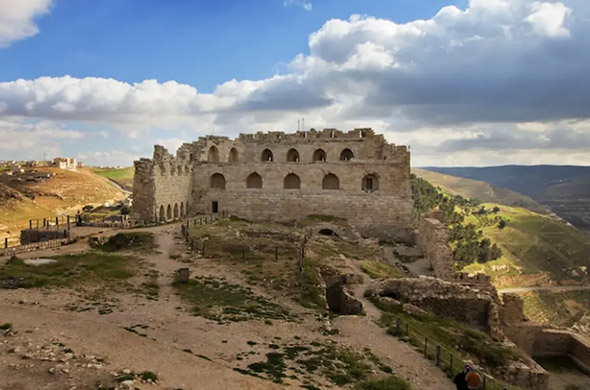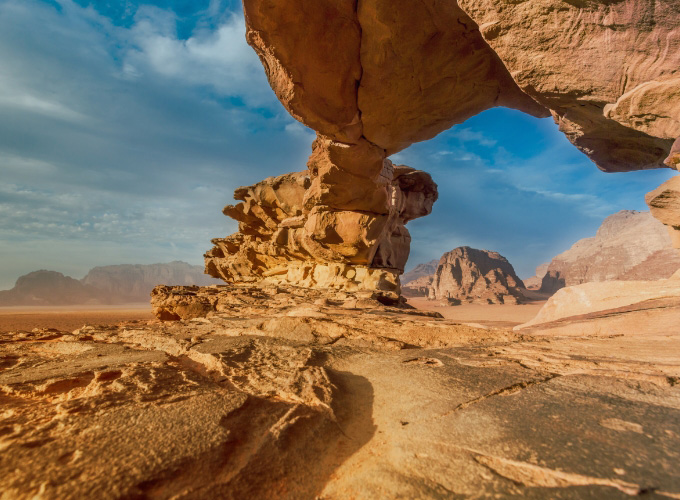Ajloun Castle
This 12th-century Muslim citadel crowns a hilltop of the Mount Ajloun district in north-western Jordan. The castle was built by the Ayyubids to guard the three valleys descending towards the Jordan Valley.
In the 13th century, Ajloun Castle was expanded by the Mamluks, who built its gate and added a new tower. In 1260 AD, the Mongols destroyed parts of it, but Mamluk Sultan Al-Zahir Baibars restored it following his Ain Jalut victory.
The castle was again destroyed in 1837 and 1927, but this time due to powerful earthquakes.

Jerash
Located 48 km north of Amman, Jerash is home to some of the world’s best-preserved Roman architecture. The first human settlement discovered in Jerash inhabited Tal Abu Sowan, a site that has existed since the Neolithic age, in 7500 BC. Other ruins discovered in Jerash belong to the Bronze age, as well as the Hellenistic, Roman, Byzantine, early Muslim, Crusaders, and mid to late Muslim periods.
Soak up the rich history when you visit the Temple of Artemis, Cardo Maximus, the Arch of Hadrian, the Hippodrome, the North Theatre, the Archaeological Museum, the Temple of Zeus, the Nympheum, and many more historic sites.

Petra
This southern city adjacent to Jabal Al-Madbah is believed to have been inhabited since 7000 BC. The Nabateans, who made Petra the capital of their kingdom in the fourth century BC, had turned the city into an incense trading hub.
In 106 AD, the Roman Empire annexed Nabatea and renamed Petra as Arabia Petrea. Then in 363, an earthquake destroyed many of the structures built by the Nabateans.
The city, dubbed the Rose City owing to the colour of its stone, is accessed through a giant gorge known as Al-Siq, which leads to The Treasury, both of which are important ruins.

Qasr Bashir
Qasr Bshir is a square-structured desert fortress located 100 km east of Amman. It neighbours the Azraq, the only water source in this large desert region. The Romans were the first to use this castle for military reasons.
In the 13th century, the Ayyubids renovated Qasr Bshir using locally mined basalt, giving the fortress a darker façade. Then, in the 16th century, the Ottomans used it for military reasons during their rule over the region.
During the winter of 1917, British Colonel Thomas Edward Lawrence, known as Lawrence of Arabia, made the castle his desert headquarters.

Umm Qais
Situated 28 km from Irbid, in the hills above the Jordan Valley, this northern town is home to the ruins of Gadara, an ancient Hellenistic city that was part of the Greco-Roman Decapolis. Due to its strategic location, the city was repeatedly the focus of military invasions during the Syrian Wars between 274 and 188 BCE.
Gadara – or Umm Qais – has archaeological remnants dating back to the second half of the 3rd century BC. It’s believed to have been established as a military colony by Alexander the Great’s Macedonian Greeks.

Um ar-Rasas (Kastrom Mefa’a)
Southeast of Madaba sits the archaeological site Um ar-Rasas, which was first founded as a Roman military camp. It’s home to well-preserved ruins dating back to the 3rd - 9th centuries – from the Roman, Byzantine and Early Muslim periods.
Um ar-Rasas was named a World Heritage Site in 2004, and most of the gems it hides have not yet been excavated, as archaeologists have been focused on the Byzantine churches. The town is home to 16 churches, several of which boast well-preserved floor mosaics, with the largest sanctuary being the Church of St. Stephen.

Quseir (or Qasr) Amra
The remnant of a larger castle, Quseir Amra is a desert structure located in eastern Jordan. It was built by the Umayyad caliph Al-Walid ibn Yazid, also known as Al-Walid II, as a royal retreat. He was known to have a love for luxury as depicted on the frescoes on the inside walls.
One of the frescoes features Persian animals, suggesting that area’s influence as Al-Walid’s mother was a Persian princess. Another fresco shows the Umayyad caliph with several rulers, four of whom were identified as the Visigoth King Roderic, the Byzantine emperor, the Sassanid Persian Shah, and the Negus of Ethiopia.

Kerak Castle
One of the largest castles in the Levant, Kerak is a medieval castle constructed by Fulk, king of Jerusalem and pagan lord of Oultrejordain. Due to its strategic location east of the Dead Sea, Kerak Castle controlled the trade routes from Damascus to Egypt and Mecca.
During the Crusades in 1176, Raynald of Châtillon gained control of Kerak and used his power to harass trade camel trains. Salahuddin besieged the castle in response in 1183 and then again in 1184, but the Muslims didn’t take possession of the castle until 1188, following a siege by Saad Ad-Din, Salahuddin’s nephew.

Church of Saint George at Madaba
Madaba is home to several impressive churches, including the Greek Orthodox St. George’s Church, built in 1884. However, during its construction, builders found the Byzantine Madaba Mosaic Map, which was created in the 6th century and was hidden following a devastating earthquake that hit the region in 746.
The map provides a cartographic depiction of the Holy Land, depicting all the major biblical sites in the Middle East, from Egypt to Palestine. The Sasanian Empire seized Madaba in 614. In the 8th century, the Umayyads had some figural motifs removed from the mosaic.

Abila
Also called Peraea, Abila is an ancient city in Irbid, east of the Jordan River. It was founded during the Middle Bronze Age in 1950 BC.
It is said that Abila was full of palm trees in the 1st century CE, producing some of the best dates in the region. These dates were depicted in the Madaba Mosaic Map, and Flavius Josephus, a 1st-century Romano-Jewish historian, had written about the dates of Abila.

The Roman Amphitheatre
One of the most celebrated historical landmarks in the Jordanian capital Amman, the 6,000-seat Roman Theatre was built in the 2nd century in honour of Emperor Antoninus Pius, when the city was called Philadelphia. It sits at the foot of Jabal Al-Joufah opposite the Amman Citadel.
The structure is oriented north to protect the spectators from the sun, and it had side entrances at the ground level, leading to the orchestra and the stage. It also houses two museums: the Jordan Museum of Popular Tradition and the Jordan Folklore Museum.

Amman Citadel
On one of the L-shaped hills in downtown Amman sits the magnificent Amman Citadel. It was built during the Bronze Age and became the capital of the Kingdom of Ammon after 1200 BC. The fortress was occupied by many civilizations, including the Neo-Assyrian Empire, the Neo-Babylonian Empire, the Ptolemies, the Seleucids, the Romans, the Byzantines, and the Umayyads.
It is believed that a large part of the citadel remains unexcavated. It is home to the Roman Temple of Hercules, which dates back to the 2nd century CE, and the Umayyad Palace, built during Umayyad rule and used as an administrative building.

Mount Nebo
Part of the Abarim mountain range, Mount Nebo rises about 710 m above sea level. Its significance comes from its biblical reference as the place from which Moses was granted a view of the Promised Land – the Land of Canaan.
At the summit, stands a serpentine cross sculpture created by Italian artist Giovanni Fantoni. The summit also provides a panoramic view of the West Bank, the city of Jericho, and Jerusalem. The remains of a 4th century Byzantine church erected on the highest point of Mount Nebo were uncovered in 1933.



